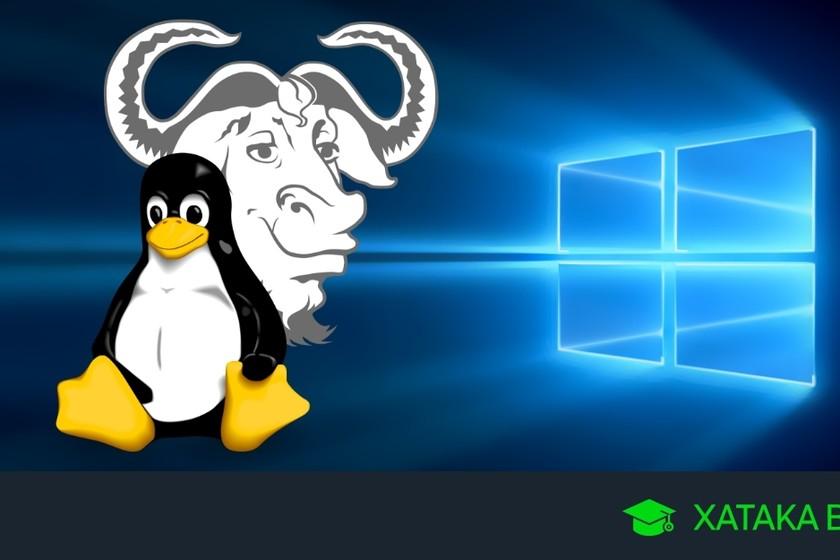Tutorial
A new window will open. In the left column, click on Turn Windows features on or off. You'll see a long list of options. We search for Windows Subsystem for Linux and mark it:
Click on Accept. We will have to restart Windows to activate linux in Windows 10.
Download Linux distros from the Microsoft Store
Now we can use Linux distros as a Windows program. We can even download them from the Windows Store, which is now called the Microsoft Store.
In the Windows search engine, in the bottom bar of the Desktop, we put Microsoft Store. Already in the Windows store, we type in the search engine: Linux or Ubuntu:
At the moment we can find three Linux distros: Ubuntu, openSUSE Leap 42 and SUSE Linux EnterpriseServer. More will arrive shortly.
They are the full versions. For example, Ubuntu allows you to use the Ubuntu Terminal and use command lines with bash, ssh, git, etc.
Click on the Get button, and they will be downloaded and installed as a Windows program.
Get Linux distros up and running
Once downloaded, you just have to click on its icon to start them up. You'll find them in the list of installed apps on the Home Button, in the left column:
The first time you use them, they will take a few minutes to install. Then you will access the command console of the Linux distro. You will have to enter a username and password, and we can now use commands or install Linux programs.
We can even run several distros at the same time, in a window. Impressive!:
Invest in #Bonds! We present a FREE #Bonds Masterclass TOMORROW. Learn how to use this #investment to make the… https://t.co/SJ6HTw0553
— AIB-AXYS Africa Mon Jul 26 08:06:44 +0000 2021

Keep in mind that these are the non-GUI versions, designed for developers or people who want full control over Linux, using the command line. In this way it is possible to develop or install Linux applications from Windows 10.
See gallery
10 images
The 9 curiosities of Linux that you did not know
(10 images)
On August 25, 1991, a university student announces the development of an operating system. It was Linus Torvalds and the SOP was Linux. On the occasion of his anniversary, we tell you 9 curiosities about the operating system.
Linus Torvalds posted a message on the Minix group at 20:57:08 GMT on August 25, 1991 announcing the development of Linux. However, there is some controversy with the date of its creation. And it is that, if that day Linus Torvalds revealed his intentions, on October 5, 1991, in another message to the same forum, he announced the publication of the first kernel.
The GNU project, in 1991, lacked drivers and a kernel, that was what led Linus Torvalds to tackle the development of the Linux kernel. If GNU had it, Torvalds probably wouldn't have worked on it.
One of the sectors where Linux is used the most is in the film industry. So much so, that 95% of the servers used by Hollywood studios to make animated films have some GNU/Linux distribution installed. In fact, Titanic and Avatar used it for the development of their special effects.
90% of the most powerful computers in the world use GNU/Linux. In fact, data center penetration is very high: 33.8% of global servers run on this operating system, compared to 7.3% on Windows. For example, Google servers and the server that hosts the White House website run on Linux.
If Linux has a penguin as its logo, it is thanks to Linus Torvalds. The idea came to him because, as a child, he was stung by one and thought it was funny that it was the pet of his system. As with his birth, the origin of the name also causes some controversy. There are some who say that it comes from the fact that the penguins seem to be dressed in a tuxedo, which in English is said tuxedo max and is abbreviated “tux”; others claim that it has to do with the fact that the letters in Tux are the anagram of Torvalds Unix.
Linux has more than 9.2 million lines of code and this number is growing by 10% every year. Of these 9.2 million lines, the kernel itself accounts for 5% and the drivers for 55%. 4,500 lines are added, 1,800 are removed, and 1,500 are modified each day.
By 2002, Microsoft had racked up $421 million in spending fighting the spread of Linux, according to The Register.
Linux is present in very sensitive sectors. Among them are Japan's bullet trains, San Francisco traffic control, the New York Stock Exchange, CERN, aerial control systems or the control of submarine nuclear reactors and nuclear warships.
There are currently more than 300 active GNU/Linux distributions. Photo: Pichost.
Without mining or Portezuelo, a company that produces wine is born in Malargüe
Goodbye to Carlos Marín: this is the heritage and fortune left by the singer of Il Divo
Record of women affiliated with Social Security, but temporary and with low salaries
Ceviche to Recoleta and croissants for officials: the bet of the workers of Villa 31 to sell outside the neighborhood